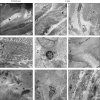Scleral ultrastructure and biomechanical changes in rabbits after negative lens application
- PMID: 29600166
- PMCID: PMC5861222
- DOI: 10.18240/ijo.2018.03.02
Scleral ultrastructure and biomechanical changes in rabbits after negative lens application
Abstract
Aim: To address the microstructure and biomechanical changes of the sclera of rabbits after negative lens application by spectacle frame apparatus.
Methods: Five New Zealand rabbits of seven weeks post-natal were treated with -8 D lens monocularly over the course of two weeks. Refractive errors and axial length (AXL) were measured at the 1st, 7th and 14th days of the induction period. Ultrastructure of sclera was determined with electron microscopy. Biomechanical properties were tested by an Instron 5565 universal testing machine.
Results: Lens-induced (LI) eyes elongated more rapidly compared with fellow eyes with AXL values of 15.56±0.14 and 15.21±0.14 mm (P<0.01). Fibril diameter was significantly smaller in the LI eyes compared with control ones in the inner, middle, and outer layers (inner layer, 63.533 vs 76.467 nm; middle layer, 92.647 vs 123.984 nm; outer layer, 86.999 vs 134.257 nm, P<0.01, respectively). In comparison with control eyes, macrophage-like cells that engulfed fibroblasts, dilated endoplasmic reticulum, and vacuoles in fibroblasts were observed in the inner and middle stroma in the LI eyes. Ultimate stress and Young's modulus were lower in the LI eyes compared with those in the control eyes.
Conclusion: Negative lens application alters eye growth, and results in axial elongation with changes in scleral ultrastructural and mechanical properties.
Keywords: biomechanics; negative lens; rabbit; sclera; ultrastructure.
Figures







Similar articles
-
Scleral Cross-Linking Using Glyceraldehyde for the Prevention of Axial Elongation in the Rabbit: Blocked Axial Elongation and Altered Scleral Microstructure.Curr Eye Res. 2019 Feb;44(2):162-171. doi: 10.1080/02713683.2018.1522647. Epub 2018 Oct 22. Curr Eye Res. 2019. PMID: 30222005
-
The ultrastructure of rabbit sclera after scleral crosslinking with riboflavin and blue light of different intensities.Graefes Arch Clin Exp Ophthalmol. 2016 Aug;254(8):1567-1577. doi: 10.1007/s00417-016-3393-z. Epub 2016 Jun 6. Graefes Arch Clin Exp Ophthalmol. 2016. PMID: 27270346
-
[Experimental study of glyceraldehyde cross-linking of posterior scleral on FDM in guinea pigs].Zhonghua Yan Ke Za Zhi. 2014 Jan;50(1):51-9. Zhonghua Yan Ke Za Zhi. 2014. PMID: 24709134 Chinese.
-
Cross-linking of scleral collagen in the rabbit using riboflavin and UVA.Acta Ophthalmol Scand. 2005 Aug;83(4):477-82. doi: 10.1111/j.1600-0420.2005.00447.x. Acta Ophthalmol Scand. 2005. PMID: 16029274
-
Biomechanics of the sclera in myopia: extracellular and cellular factors.Optom Vis Sci. 2009 Jan;86(1):E23-30. doi: 10.1097/OPX.0b013e3181940669. Optom Vis Sci. 2009. PMID: 19104466 Review.
Cited by
-
Scleral structure and biomechanics.Prog Retin Eye Res. 2020 Jan;74:100773. doi: 10.1016/j.preteyeres.2019.100773. Epub 2019 Aug 11. Prog Retin Eye Res. 2020. PMID: 31412277 Free PMC article. Review.
-
Eye morphometry, body size, and flexibility parameters in myopic adolescents.Sci Rep. 2024 Mar 21;14(1):6787. doi: 10.1038/s41598-024-57347-w. Sci Rep. 2024. PMID: 38514709 Free PMC article.
-
Assessment of anterior scleral thickness in myopes and emmetropes using anterior segment optical coherence tomography.Mol Vis. 2024 Apr 22;30:229-238. eCollection 2024. Mol Vis. 2024. PMID: 39563681 Free PMC article.
-
Animal modeling for myopia.Adv Ophthalmol Pract Res. 2024 Jun 5;4(4):173-181. doi: 10.1016/j.aopr.2024.06.001. eCollection 2024 Nov-Dec. Adv Ophthalmol Pract Res. 2024. PMID: 39263386 Free PMC article. Review.
-
Scleral growth stunting via sub-Tenon injection of cross-linking solutions in live rabbits.Br J Ophthalmol. 2023 Jun;107(6):889-894. doi: 10.1136/bjophthalmol-2021-319427. Epub 2021 Oct 20. Br J Ophthalmol. 2023. PMID: 34670748 Free PMC article.
References
-
- Rada JA, Shelton S, Norton TT. The sclera and myopia. Exp Eye Res. 2006;82(2):185–200. - PubMed
-
- Lin Z, Chen X, Ge J, Cui D, Wu J, Tang F, Tan J, Zhong X, Gao Q. Effects of direct intravitreal dopamine injection on sclera and retina in form-deprived myopic rabbits. J Ocul Pharmacol Ther. 2008;24(6):543–550. - PubMed
-
- McBrien NA, Jobling AI, Gentle A. Biomechanics of the sclera in myopia: extracellular and cellular factors. Optom Vis Sci. 2009;86(1):23–30. - PubMed
LinkOut - more resources
Full Text Sources
Other Literature Sources
Research Materials
Miscellaneous
